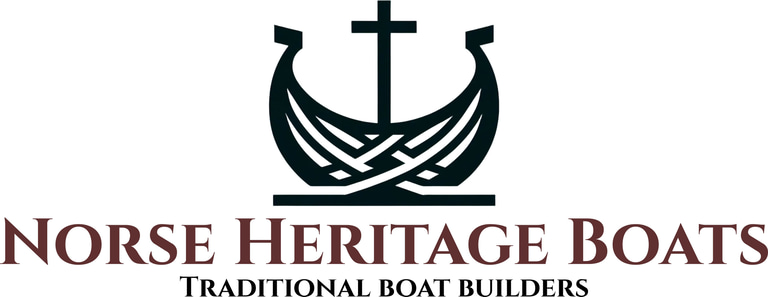UNIQUE! - Check out our Selfbuilding workshop!
Our Boats
After a long time of diligent searching, we found the perfect boat to fulfil our boating philosophy - the "Ilur", designed by our partner, the internationally renowned naval architect from Brittany - Francois Vivier. Ilur is his most successful design, among his dozens of great designs. It is a beautiful, stable, easy-sailed and seaworthy touring boat for 1 to 5 people. It has a hull length of 15 feet + eventual bowsprit or mizzen. Check out Vivier's other designs we can build on his own website here.
With a rigged down and ready for transport length of 4,5 metres and a weight of less than 300kg, it may be easily transported on a boat trailer behind most regular family cars, and takes up little space for storing when not in use.
Francois Vivier designed Ilur more than 40 years ago and the first boat was built in 1985. Since then more than 1000 construction plans have been sold worldwide, with exclusively positive feedback. The boats are not often found on the second-hand market - the owners like to keep them, and eventually pass them on to the next generation. This is a good indication of the popularity of these boats.
The "Ilur" has won several prestigious awards at boat shows and festivals around the world, from Australia to Europe and North America, in addition to very honourable mentions in boat magazines.
In earlier times, the hull was made watertight by caulking with wool and tar between the planks overlap. As solid wood contracts and expands depending on exposure to humidity, the hull was leaking a little if the boat was kept out of water for some time, needing to be put back in water for a few days, for the planks to swell up and the overlaps to become watertight again.
Ilur
Like the ancient Viking ships, Ilur is a "sail & oar boat", the oars mainly used if the wind dies down completely, or manoeuvring in narrow environments. In our modern times many Ilur owners have replaced the rowing by a small outboard engine (often electric), easily hooked on to the transom.
The Ilur’s genes come straight from the open workboat tradition of the Breton coast. The plumb stem and good wide transom, the firm bilges curving down to a long central keel for directional stability, decent freeboard and buoyant sections speak of a boat that’ll look after you when things get tough. Although Ilur 's hull may be built with different techniques (like carvel planking or strip-planking), our by far favourite is clinker planking, also known as lapstrake.
Clinker built boats were invented and perfected by the Norsemen - the Vikings - more than 1000 years ago, a revolutionary method still revered today. They make for a lightweight, yet very strong construction by the overlapping hull planks - also called strakes.
Also, the visual overlaps accentuate the beautiful lines of the hull.
Traditionally the users of these kinds of workboats wanted a boat that was seaworthy, spacious, stable, easy to work from and simple to handle when sailing.
Modern leisure sailors have slightly different requirements: comfort, easy handling, transport ability, versatility for diverse activities like sailing, fishing, preparing food, sleeping - and not to forget their pride in a beautiful boat.
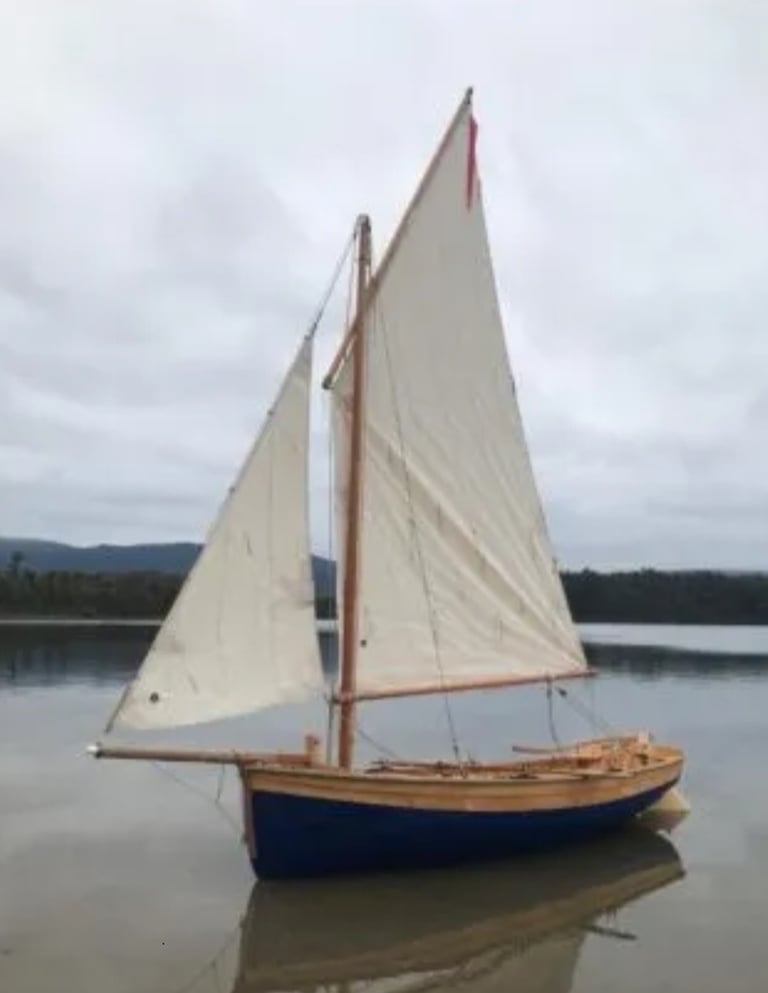

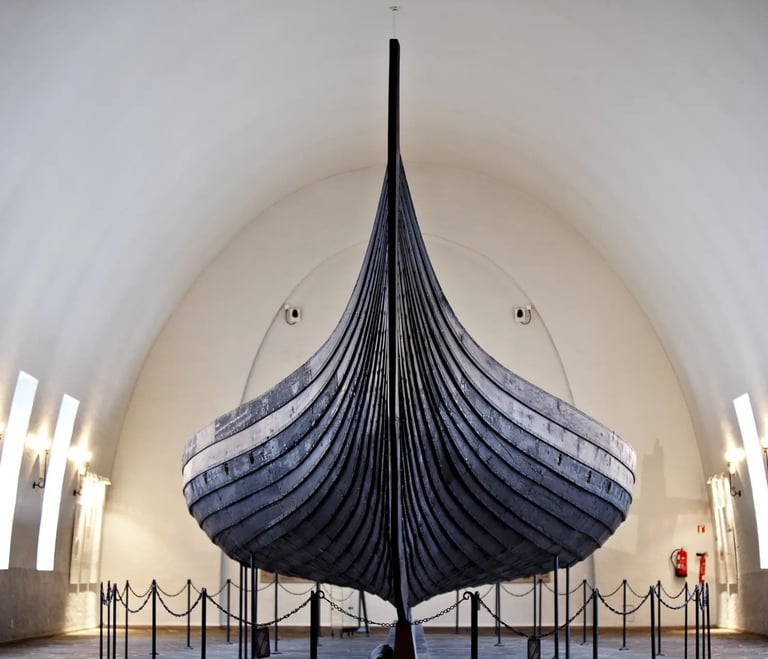

The Gokstad Viking ship, clearly showing the clinker laps
With today's access to new materials, this handicap is completely overcome by making the hull planks from the best marine grade plywood, which in this regard is much more stable than solid timber planks. Subsequently, they are impregnated with epoxy and assembled, including attachment to each other and to the frames, using epoxy in conjunction with screws or rivets.
Although we can build many different models of boats, they all have much in common:
Materials used are mainly various species of first class timber, prime marine plywood and exclusive bronze fittings
Our preferred method for the hull is clinker construction, (but carvel- or strip-planking is available)
Extensive use of epoxy for impregnating and gluing wooden parts, reinforced by bronze or stainless steel screws
Many layers of oiling for mast and spars, decks, seats and floor
Lug- or gaff-rig, for quick and easy rigging and launching, to facilitate trailering
Retractable swing-keel and bow-sprit
Use of machine tools for cutting, dimensioning and sanding, but use of traditional hand tools for shaping and fitting parts, done to optimal perfection by trained craftsmen.
An Ilur sloop, "Elandra", built by the Wooden Boat Centre, Tasmania.
We have chosen to use one design in particular to illustrate our boats and how they are built, our signature model - a wonderful day-sailer called "Ilur".
Interior
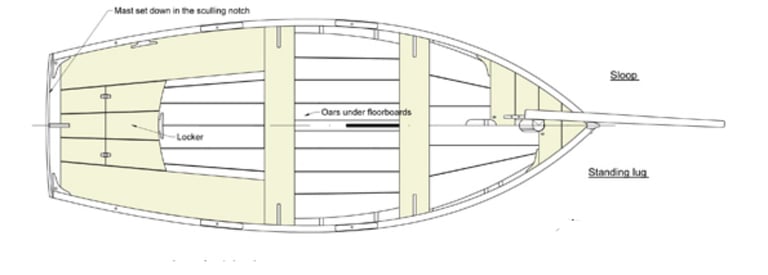

The "backbone" of a boat are the transverse curved frames, defining the shape of the hull, and the most important contribution to its solidity. There are different ways of constructing them - by steam-bending, integrating them as part of the bulkheads, or laminating.
Many professional small boat builders prefer steam-bent, thinner frames - mostly because of the quickness of building. We prefer laminating them from layers of multiple strips of wood, which makes very strongest frames.
The Ilur also has bulkheads, to make some lockable storage space, as well as buoyancy compartments needed for safety. Underneath the floor, in the bilges, there is storage space for oars, anchor, water pump etc., and may be a few bottles of cold drink.
The width of 1,7m and the the ample freeeboard makes the Ilur quite spacious for its size. But with space on board a small boat at a premium, it is most efficient to pack most of your personal gear for longer trips in watertight bags strapped to the seat risers.
In addition to the side and aft seats there are two thwarts across the interior, for seating a full complement of crew, and for rowing. The aft thwart is removable to make more freedom of movement on board when the thwart is not needed.
In the middle of the boat is the centreboard case, containing the retractable pivoting centreboard, which is needed on a trailerable sailboat without a fixed keel. The centreboard case is located and constructed in such a way as not being being obstructive to the crew's movements.
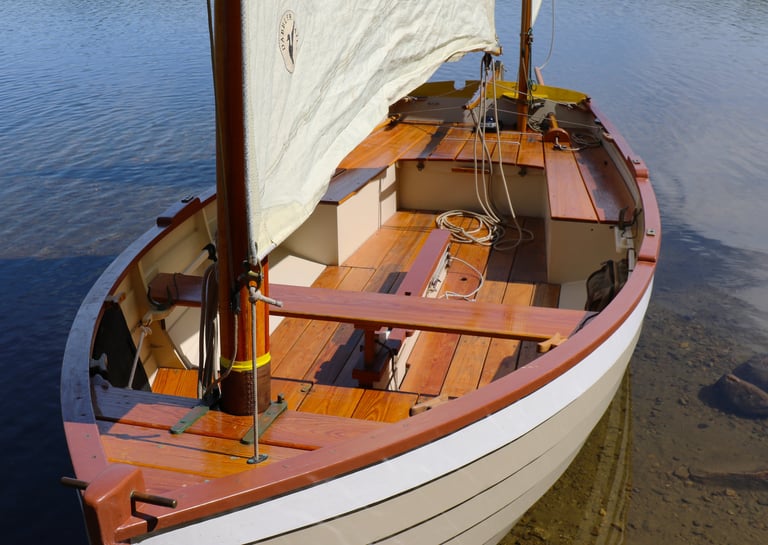

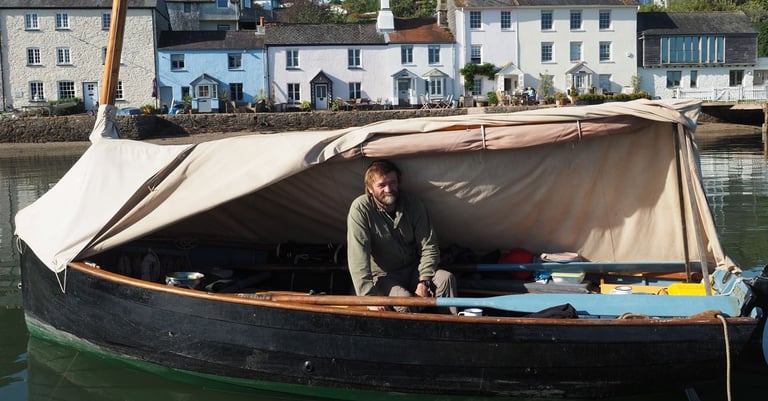

Roger Barnes, president of the Dinghy Crusing Association, inside the boom tent of his "Avel Dro", an early Ilur built in 1994.
John Hartman's (USA) yawl rigged Ilur "Waxwing"
The Ilur is an open boat, without a cabin. On most boats with a cabin the people on board are usually staying in the cockpit all the time when the boat is under way. On such a small boat where space is at a premium, a cabin would take a lot of space away and reduce the size of the cockpit. The solution is instead a boom tent, easily erected when in port, for protection against weather and to facilitate comfortable sleeping space for two adults.
Fittings - the jewels of the crown
A beautiful traditional boat really deserves equally beautiful traditional fittings and equipment. Many of these we handcraft ourselves, like wooden cheeked blocks, cleats, etc. Traditional manila or hemp ropes have some disadvantages of durability and use, so we prefer modern material ropes coloured to look as close to the traditional ropes as possible. Some parts, particularly some bronze parts, we source from other suppliers, as we do not have a foundry ourselves. There are few suppliers of traditional boat fittings left, so these parts we source from all over the world.
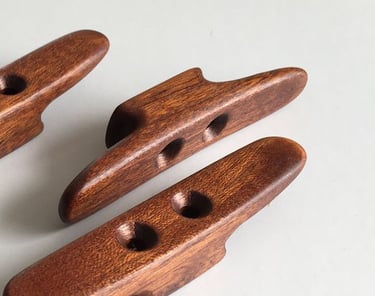

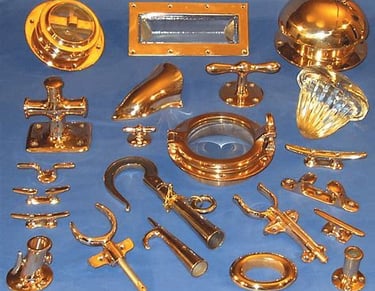

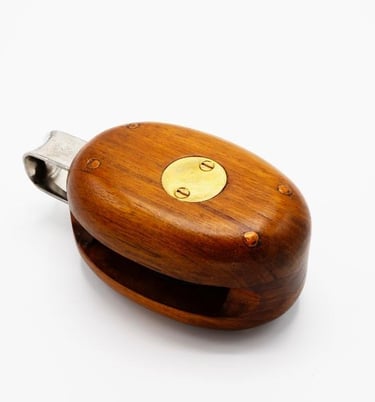

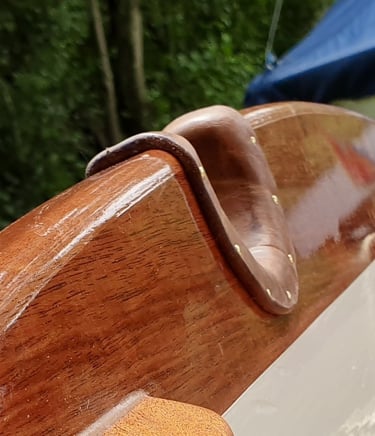

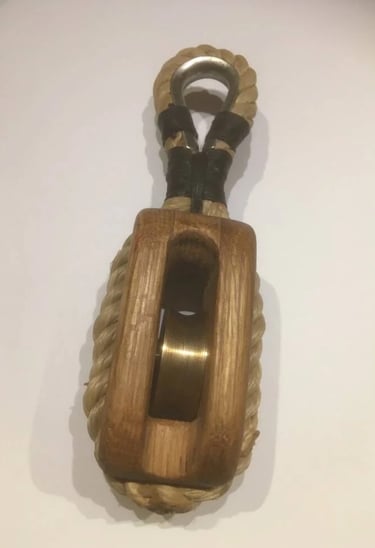

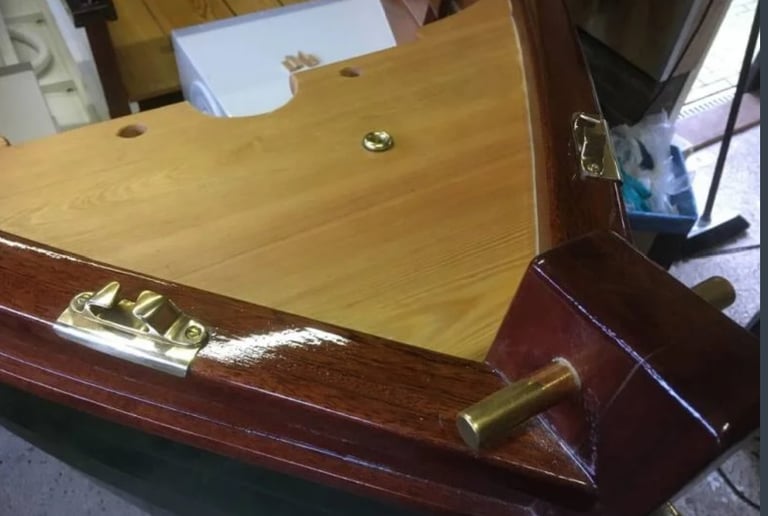

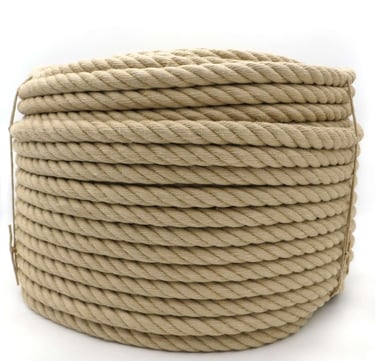

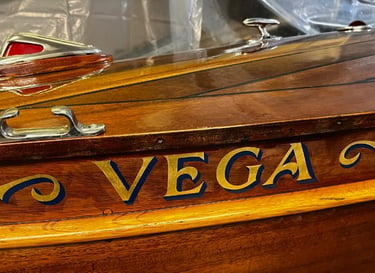

Rigging
Even though the Norsemen built brilliant boats, their sails were rather simple square-rigged sails, not always efficient for upwind sailing. Many years later sails mounted lengthwise on the boat became popular - in Europe particularly the gaff rig. Since then, there came variations of the Gaff, like Gunther rig and the Lug rig.
The most modern rigging today is the Bermuda rig, which is specially very efficient for upwind sailing - beating. This is important for competition sailors, as a major part of the time spent on the racecourse is sailing against the wind. This rigging has also become the most popular rigging for crusing sailboats.
But it does not come without disadvantages!
It calls for a very tall mast, with the center point of effort high up in the sail. This necessitates reinforcement of the mast by means of stays and shrouds under great tension.
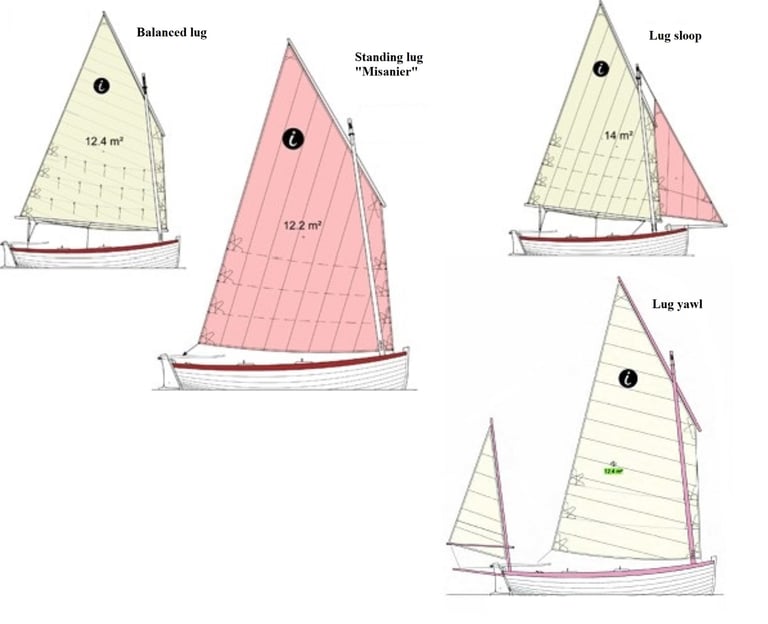

Lug rigging options
The Ilur comes with four optional rigs:
Standing lug ("Misanier")
This is the original rig for this type of boat. Very simple, with one sail, only one spar(the yard) in addition to the mast. The sail is attached only to the yard, the downhaul by the tack and the mainsheet at the clew.
Advantages:
The simplest and cheapest option.
Only two ropes to handle - the mainsheet and the downhaul
No boom to hit your head when changing tack
Disadvantages:
Not the most efficient when running downwind or reaching, unless you use a pole between the mast and clew to keep the sail open.
Need to move the mainsheet attachment from one side of the boat to the other when changing tack.
Balanced lug
This rig is fitted with a boom, to which the sail is also attached.
Advantages:
More efficient and powerful than the misanier
No need for a pole
Easier tacking, for instance by river sailing
Disadvantages:
The boom may hit your head hard when tacking or jibing, if you are standing up
Lug sloop
This is the rig closest to a modern rig in handling. The mainsail is slightly smaller than the balanced lug, but the boat comes with a boom, jib and retractable bowsprit.
Advantages:
The most powerful and fastest rig.
Very good rig for sailing upwind
Many options of reducing sail and reefing if the wind picks up.
The bowsprit may be retracted completely back into the boat, making sail setting/reefing as well as docking in crowded ports and transport easier.
Beautiful looks
Disadvantages:
More to handle for one person when changing tack or reducing sail
More ropes in the cockpit
Lug yawl
The yawl does not have a boom, nor a jib, but a reduced mainsail and a small mizzen sail on the stern. On the Ilur the mizzen is offset a bit to the side of the centreline, not to conflict with the rudder or tiller. Mizzens are not so common on leisure boats in Europe, but quite popular on the east coast of USA. However, mizzens are often used on small working boats - also motor boats - to stabilize rolling caused by wind and waves when working.
Advantages:
The mizzen makes the boat stable against rolling and when stopping and pointing into the wind for fishing or reefing.
Good windward qualities
The mizzen is self-tacking, making it much easier to come about, with only a smaller mainsail to handle.
Disadvantages:
The mizzen is not a very powerful sail, and does not contribute so much to the speed of the boat, and with the smaller mainsail making it not the fastest rigging option.
It adds more gear and ropes cluttering the aft end of the boat, near the helmsman, tiller and mainsheet.
It is the most expensive rig option, with an extra mast, the extra pole, the bumpkin spar and the mizzen mast mounting brackets.
For a boat that spends time both on water, land and under transport, a tall mast laying down and sticking out far beyond the boat during transport is not optimal. Raising a tall mast and mounting and adjusting the tension of stays and shrouds each time the rigging is set up or taken down requires considerable time and effort.
This is one good reason why the designer of the Ilur, Francois Vivier, has chosen a high aspect lug rig for his boats. The height of the rig consists of two parts, the shorter mast and the steep angled yard on top of the sail. The sail is wider than on a Bermuda rig, so the point of effort is lower in the sail. Thus, no stays and shrouds are needed. This rig is also quite efficient in all points of the wind. It makes rigging and preparing for sailing much easier and quicker for a single person (a matter of minutes). Of course, for aestetics, this rig is also more "time-right" for a traditional style boat.
The main characteristics of the lug is that the sail is not attached to the mast, but protrudes beyond the front of the mast. This has proved to be very efficient for the sail's performance. The fact that the mainsail is not attached to the mast makes hoisting or lowering the sail very fast when needed. Dipping the yard makes it easy to pass under low bridges and the like. If needed, laying down the whole mast is also simple enough.
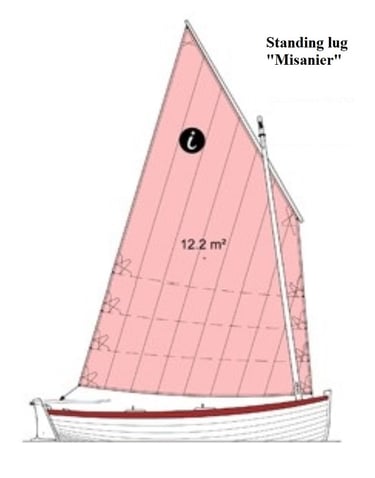

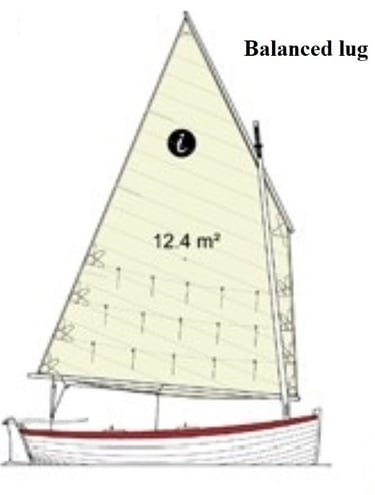

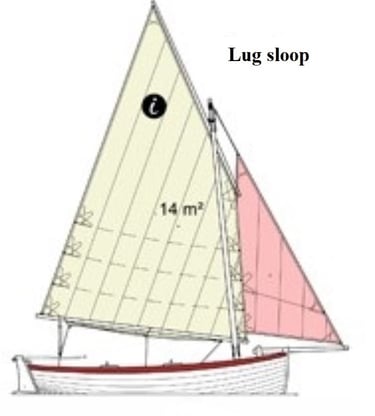

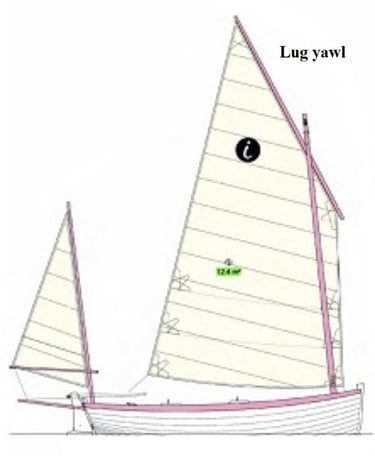

Certification
Ilur built at Norse Heritage Boats according to specifications will be issued a CE certificate valid in all EU and EA. This is now compulsory for all boats of all sizes with only a few exceptions.
The CE certification is all about seaworthiness and rightability at capsizing etc., and has 4 categories:
A - Ocean (larger boats with ocean crossing capacity)
B - Offshore (larger boats operating far from land, in tough conditions)
C - Inshore (coastal waters in weather conditions up to light gale, and medium high wave height of 2 metres)
D - Sheltered waters (along the coast with better weather conditions and lesser wave height)
The Ilur, being a small and open boat, is approved for category C for up to 3 people on board, and category D for up to 5 people.
Certification is important if you want to sell your boat, or to have it insured!
© 2025. All rights reserved.
